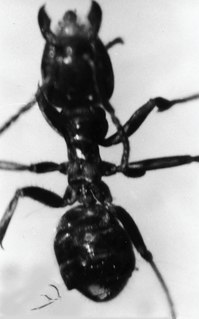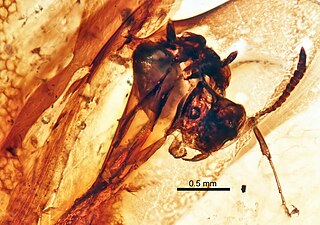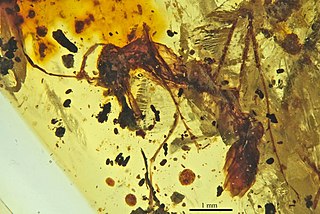
Dolichoderinae is a subfamily of ants, which includes species such as the Argentine ant, the erratic ant, the odorous house ant, and the cone ant. The subfamily presents a great diversity of species throughout the world, distributed in different biogeographic regions, from the Palearctic, Nearctic, Afrotropical region and Malaysia, to the Middle East, Australian, and Neotropical regions.

Amyrmex golbachi is a rare Neotropical species of ant and the only known species in the genus Amyrmex. It is currently only known from males from the Amazon basin of Brazil and from northern Argentina.

Leptomyrmex, or spider ants, is a genus of ants and a distinctive member of the ant subfamily Dolichoderinae. Commonly known as "spider ants" for their long legs and spider-like movements, these orange and black ants are prominent residents of intact wet forest and sclerophyll habitats throughout their range. One extant species, Leptomyrmex relictus, is known from central Brazil; otherwise, the global distribution of this genus is restricted to eastern Australia, New Caledonia and New Guinea, as well as the nearby Indonesian islands of Aru and Seram.

Prionomyrmex is an extinct genus of bulldog ants in the subfamily Myrmeciinae of the family Formicidae. It was first described by Gustav Mayr in 1868, after he collected a holotype worker of P. longiceps in Baltic amber. Three species are currently described, characterised by their long mandibles, slender bodies and large size. These ants are known from the Eocene and Late Oligocene, with fossil specimens only found around Europe. It is suggested that these ants preferred to live in jungles, with one species assumed to be an arboreal nesting species. These ants had a powerful stinger that was used to subdue prey. In 2000, it was suggested by Cesare Baroni Urbani that the living species Nothomyrmecia macrops and a species he described both belonged to Prionomyrmex, but this proposal has not been widely accepted by the entomological community. Instead, scientists still classify the two genera distinctive from each other, making Nothomyrmecia a valid genus.

Sphecomyrminae is an extinct subfamily of ants in family Formicidae known from a series of Cretaceous fossils found in North America, Europe, and Asia. Sphecomyrminae contains ten genera, divided into two tribes, Haidomyrmecini and Sphecomyrmini. The tribe Haidomyrmecini contains the five genera Ceratomyrmex, Haidomyrmex, Haidomyrmodes, Haidoterminus and Linguamyrmex, while Sphecomyrmini contains Baikuris, Cretomyrma, Dlusskyidris, Sphecomyrma, and Zigrasimecia. The genus Sphecomyrmodes was formerly placed into Sphecomyrmini; however, in 2016, it was made a synonym of the stem group genus Gerontoformica, which is considered incertae sedis in Formicidae.

Azteca alpha is an extinct species of ant in the subfamily Dolichoderinae known from possibly Miocene fossils found on Hispaniola. A. alpha is one of only two species in the genus Azteca to have been described from fossils, both found in Dominican amber. It is the host for a fossil nematode, and has been preserved with scale insects.
Azteca eumeces is an extinct species of ant in the subfamily Dolichoderinae known from possibly Miocene fossils found on Hispaniola. A. eumeces is one of only two species in the ant genus Azteca to have been described from fossils, both found in Dominican amber.

Chronomyrmex is an extinct genus of ants of the subfamily Dolichoderinae. The genus only contains a single species Chronomyrmex medicinehatensis, discovered in Canada and described in 2013.

Usomyrma is an extinct genus of ant in the formicid subfamily Dolichoderinae. The genus contains a single described species, Usomyrma mirabilis, that is known from two Middle Eocene fossils which were found in Scandinavian amber in Denmark.

Gracilidris pombero is a species of ant in the genus Gracilidris. Described by Wild and Cuezzo in 2006, the species is endemic to the South American countries of Argentina, Brazil and Paraguay.
Dolichoderus caribbaeus is an extinct species of ant in the genus Dolichoderus. Remains were found in the Dominican Amber, and they were described by Wilson in 1985.
Dolichoderus dibolius is an extinct species of Miocene ant in the genus Dolichoderus. The fossils were found in the Dominican Amber, and was described by Wilson in 1985.
Dolichoderus primitivus is an extinct species of Miocene ant in the genus Dolichoderus. The fossils were found in the Dominican Amber, and was described by Wilson in 1985.
Dolichoderus prolaminatus is an extinct species of Miocene ant in the genus Dolichoderus. The fossils were found in the Dominican Amber, and was described by Wilson in 1985.
Tapinoma troche is an extinct species of ant in the genus Tapinoma. Described by Wilson in 1985, fossils of the species were found in the Dominican amber, where a fossilised worker of the species was described.

Myanmyrma is an extinct genus of ants not placed into any Formicidae subfamily. Fossils of the single known species, Myanmyrma gracilis, are known from the Middle Cretaceous of Asia. The genus is one of several ants described from Middle Cretaceous ambers of Myanmar.
Cananeuretus is an extinct genus of ant in the Formicidae subfamily Aneuretinae, and is one of two Cretaceous genera of the subfamily. The genus contains a single described species Cananeuretus occidentalis and is known from one Late Cretaceous fossil which has been found in North America.














